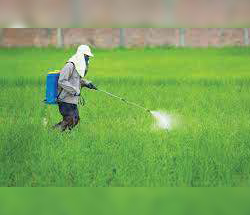Why Farmers Need To Apply Liquid Foliar Fertilizer
By William Ng’eno
-Too much rainfall leads to fertiliser leaching or surface run-off that washes away nutrients.

Crops, just like human beings and indeed all animals, need a balanced diet to thrive. Yet this truism hasn’t been appreciated by some farmers, leaving their soil poor and unable to sustain crops. They in turn don’t get enough reward for their investment.
With the continued use of the traditional dry fertilisers, which often have one or two nutrients, the rest of the ingredients, so to speak, are expected to come from the good old soil that has sustained us for decades, even centuries.
This is expecting too much from the soil! And expectedly, the nutrients in the soil get depleted over time, which will be reflected in symptoms like yellowing, purplish leaves, poor flowering, poor fruiting and ultimately reduced yields.
On a positive note, however, there is a growing mass of Kenyan farmers who are applying [liquid spray] foliar fertilisers on their crops. These are farmers who are changing with the times and climes. As the world changes, so must we, if we are to keep pace with it.
Climate change has caused unpredictable weather patterns with some areas receiving more or reduced rains than before.
Excessive rains or not enough rain complicate the application of dry fertilisers to crops. Too much rainfall leads to fertiliser leaching or surface run-off that washes away nutrients.
On the other hand, with reduced rains or prolonged droughts, farmers are unable to use dry or ground-applied fertilisers since they need moisture to dissolve and be taken up by plants.
Yet it is important to point out that foliar application is not a substitute for dry applied fertilisers, but a complement for optimal crop yields.
 What fertiliser companies need to do, however, is to ensure the products are easy and convenient to use. They should also be effective and safe for the crop. This is achieved by ensuring the products are based on raw materials with low impurities. As in life so it is even with crops. What you give them is what you get from them. Farmers who have used these foliar feeds have had a head start in the race for more produce and greater farm incomes.
What fertiliser companies need to do, however, is to ensure the products are easy and convenient to use. They should also be effective and safe for the crop. This is achieved by ensuring the products are based on raw materials with low impurities. As in life so it is even with crops. What you give them is what you get from them. Farmers who have used these foliar feeds have had a head start in the race for more produce and greater farm incomes.
Yet knowing the right thing is hardly enough for it to serve you well. How you do it is equally important.
The following are the best practices for foliar application:
Sourcing of top-quality foliars (not necessarily the cheapest) is key to achieving optimal crop yields. Good-quality foliars require one or two applications per season while poor quality ones require several applications over the crop season.
This exposes the often ‘hidden added costs’ of additional applications, reduced crop response and more expense in the long run. Always buy foliars from reputable companies with a long history of fertiliser manufacture to benefit from technology, research and quality raw materials.
It is also good practice to carry out product compatibility tests when mixing foliars with other commonly used pesticides on a small-scale before embarking on broad acreage applications. For instance, at Yara, we have what we call Yara TankMix App. This App can help you get it right.
The other important point to note is timely application. Follow the manufacturer's recommendations, especially on crop type, stage of crop and rates to be applied. These are critical to get the best outcome. It is always good to do spray water volume and equipment calibration for best results. With about 60 per cent of our arable soils being acidic, phosphorous and micronutrient availability is limited, hence, the need for high-phosphorous foliar more than ever to realise better crop start and yields.
Unto those that much has been given much is also expected, says the Good Book. If you give unto your crop by way of ground fertiliser and foliar feeds, it will give back to you in increased yield and greater profit.